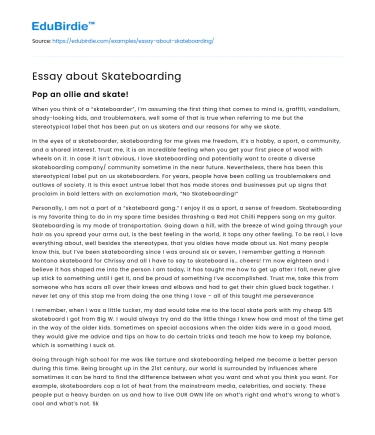Introduction
Skateboarding, an activity that originated in the United States during the 1950s, has evolved from a niche pastime into a globally recognized sport and cultural phenomenon. Initially crafted as an alternative for surfers during off-seasons, skateboarding has grown into an expression of individuality and creativity. It has also been a catalyst for community formation and social change. The sport's inclusion in the Tokyo 2020 Olympics is a testament to its rising prominence and acceptance as a legitimate athletic pursuit. This essay explores the evolution of skateboarding, its cultural and economic impact, and addresses the criticisms it faces, offering a comprehensive understanding of its place in contemporary society.
The Evolution of Skateboarding
Skateboarding's journey from a rudimentary pastime to an Olympic sport is a remarkable narrative of innovation and cultural adaptation. Initially, skateboards were no more than wooden boxes or boards with roller skate wheels attached. By the 1970s, technological advancements, such as the introduction of urethane wheels, transformed the sport, allowing for smoother rides and more complex tricks. The 1980s and 1990s marked the "golden era" of skateboarding, with figures like Tony Hawk and Rodney Mullen pushing the boundaries of what was possible on a skateboard. According to Borden (2001), skateboarding during this period became "a highly visible and influential aspect of youth culture." The development of street skating further diversified the sport, drawing more participants and audiences worldwide.
Save your time!
We can take care of your essay
- Proper editing and formatting
- Free revision, title page, and bibliography
- Flexible prices and money-back guarantee
Despite its growth, skateboarding often faced criticism and misunderstanding. Critics often perceived it as a rebellious or anti-establishment activity. However, such views overlook the discipline and creativity involved in skateboarding. Moreover, the sport's inclusion in the Olympics signifies a shift in perception, acknowledging the skill and athleticism required. Studies, such as those conducted by Beal and Weidman (2003), highlight the positive social impacts of skateboarding, emphasizing its role in fostering inclusivity and community among diverse groups. These findings challenge common stereotypes, portraying skateboarding as a constructive rather than a disruptive force.
Cultural and Economic Impact
Skateboarding's cultural impact is profound, influencing fashion, music, and art. The "skate punk" aesthetic, characterized by brands like Vans and Thrasher, has permeated mainstream culture, becoming emblematic of youthful rebellion and counterculture. Musicians and artists often draw inspiration from skateboarding, integrating its ethos into their work. This cultural symbiosis enhances skateboarding's appeal, attracting a broader audience beyond those who participate in the sport itself.
Economically, skateboarding has spawned a multibillion-dollar industry. According to a report by Grand View Research (2020), the global skateboard market size was valued at USD 1.94 billion in 2019 and is expected to expand at a compound annual growth rate (CAGR) of 3.1% from 2020 to 2027. This growth is fueled by both the sale of skateboarding equipment and the expansion of skate parks globally. Public and private investments in skate parks have increased, recognizing their potential as community hubs that promote healthy lifestyles and deter anti-social behavior. The economic benefits are not limited to direct sales and infrastructure; they also include tourism and event-related revenues, as skateboarding competitions attract international audiences.
Counter-Arguments and Rebuttals
Despite its widespread appeal, skateboarding continues to face criticisms, particularly regarding safety and public space usage. Detractors argue that skateboarding poses significant injury risks, citing studies that highlight common injuries such as fractures and sprains (Lustenberger et al., 2010). However, proponents argue that risk is inherent in most sports, and with appropriate safety measures, such as wearing protective gear and using designated skate parks, the risks can be mitigated significantly. Furthermore, the physical benefits of skateboarding, such as improved balance, strength, and cardiovascular health, often outweigh the potential downsides.
Another contention is the perception of skateboarding as a nuisance in public spaces. Critics argue that skateboarders often trespass and damage property, leading to restrictive legislation in many urban areas. However, this viewpoint fails to recognize the positive contributions skateboarding can make to urban life. Well-designed skate parks and inclusive policies can transform skateboarding into a community asset, reducing conflicts over space. As noted by Chiu (2009), integrating skateboarding into urban planning can enhance public spaces, making them more vibrant and accessible to diverse populations.
Conclusion
In conclusion, skateboarding is more than just a sport; it is a dynamic cultural force with significant social and economic implications. Its evolution from a fringe activity to an Olympic sport underscores its growing legitimacy and influence. While skateboarding does face criticisms, addressing these through thoughtful urban planning and safety measures can enhance its benefits to society. The sport's ability to foster community, inspire creativity, and contribute to economic growth highlights its multifaceted value. As skateboarding continues to evolve, it will remain a vibrant part of both urban landscapes and the global cultural fabric, challenging perceptions and inspiring future generations.






 Stuck on your essay?
Stuck on your essay?

